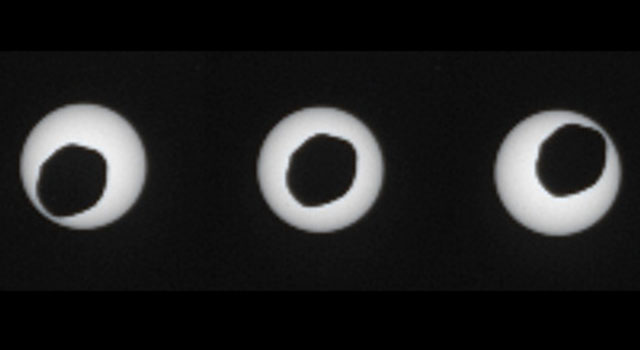Aug 29 2013
Images taken with a telephoto-lens camera on NASA's Mars rover Curiosity catch the larger of Mars' two moons, Phobos, passing directly in front of the sun -- the sharpest images of a solar eclipse ever taken at Mars.
 This set of three images shows views three seconds apart as the larger of Mars' two moons, Phobos, passed directly in front of the sun as seen by NASA's Mars rover Curiosity. (Image credit: NASA/JPL-Caltech/Malin Space Science Systems/Texas A&M Univ.)
This set of three images shows views three seconds apart as the larger of Mars' two moons, Phobos, passed directly in front of the sun as seen by NASA's Mars rover Curiosity. (Image credit: NASA/JPL-Caltech/Malin Space Science Systems/Texas A&M Univ.)
Phobos does not fully cover the sun, as seen from the surface of Mars, so the solar eclipse is what's called a ring, or annular, type. A set of three frames from Curiosity's Mast Camera (Mastcam), taken three seconds apart as Phobos eclipsed the sun, is at http://www.jpl.nasa.gov/spaceimages/details.php?id=PIA17356 .
The images are the first full-resolution frames downlinked to Earth from an Aug. 17, 2013, series. The series may later provide a movie of the eclipse. Curiosity paused during its drive that day to record the sky-watching images.
"This event occurred near noon at Curiosity's location, which put Phobos at its closest point to the rover, appearing larger against the sun than it would at other times of day," said Mark Lemmon of Texas A&M University, College Station, a co-investigator for use of Curiosity's Mastcam. "This is the closest to a total eclipse of the sun that you can have from Mars."
Observations of the Martian moons, Phobos and Deimos, by Curiosity and by the older, still-active Mars rover Opportunity are helping researchers get more precise knowledge of the moons' orbits. During the Aug. 17 observation, the position of Phobos crossing the sun was a mile or two (two or three kilometers) closer to the center of the sun's position than researchers anticipated.
Lemmon said, "This one is by far the most detailed image of any Martian lunar transit ever taken, and it is especially useful because it is annular. It was even closer to the sun's center than predicted, so we learned something."
NASA's Jet Propulsion Laboratory, a division of the California Institute of Technology, manages the Mars Science Laboratory Project for NASA's Science Mission Directorate, Washington. JPL designed and built the project's Curiosity rover.
Malin Space Science Systems, San Diego, built and operates the Mastcam instrument and two other instruments on Curiosity.